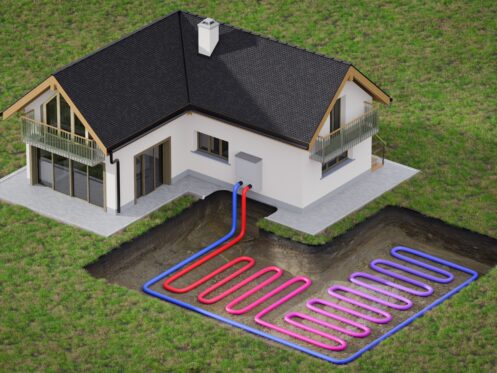Radiant heating is an incredibly efficient and comfortable method of heating your home or business, making it a popular choice among property owners. At Markool Heating & Cooling, we value the importance of educating our customers about different heating options. That’s why we’ve created this comprehensive guide to help you learn everything about radiant heating.
What’s Radiant Heating?
Radiant heating is a type of heating system that operates by warming up surfaces in a space. These surfaces then emit heat directly to nearby objects and people, creating a cozy and comfortable environment. Let’s explore the different types of radiant heating.
Electric Radiant
An electrical radiant heating system includes electric cables or mats installed under flooring like tile, carpet, or wood. These systems are easy to install and can be individually controlled for each room.
This system typically needs less maintenance and has a longer lifespan than other options. Although it has a higher operating cost, it’s highly energy efficient. As a result, it’s ideal for smaller spaces and areas that need rapid heating, like bathrooms and driveways.
Hydronic Radiant
The hydronic radiant heating system uses heated water flowing through tubing beneath the floor. The heat from the water radiates upward, providing warmth to the room. This system can also be used for wall and ceiling heating to melt roof ice and snow.
Air Radiant
The air radiant heating system operates by passing heated air through ducts in the floor, walls, or ceiling. Similar to forced-air furnaces, it relies on heating and circulating air throughout the space. This type of radiant heating is less common and is often used as a supplementary heat source for larger spaces.
Advantages of Radiant Heating System
Radiant heating systems come with a range of benefits that make them an attractive option for many property owners.
Increased Comfort and Energy Efficiency
Radiant heating systems create a cozy living space by minimizing temperature fluctuations. Unlike forced-air systems, you won’t experience sudden blasts of hot or cold air. Radiant heating also offers precise temperature control, allowing you to set different temperatures for each room.
Health Benefits
Unlike forced-air heating that circulates dust and allergens through ductwork, radiant heating promotes healthier respiratory conditions. It doesn’t dry out the air like traditional methods, making it ideal for individuals with respiratory issues or dry skin.
Safer for Pets and Young Children
Without hot air being blown through vents, there’s no risk of burns or injuries from touching hot surfaces with a radiant heating system. As a result, it is a safer option for households with pets and young children.
Increased Property Value
Installing a radiant heating system can increase the value of your property, making it an appealing option for potential buyers in the future.
Disadvantages of Radiant Heating System
While radiant heating has many advantages, it’s important to consider some of the potential downsides. Here are a few things to keep in mind when considering a radiant heating system.
More Expensive Installation Costs
One downside of radiant heating systems is the higher initial installation cost compared to traditional methods. This is due to specific requirements for heating element and distribution system installations.
Limitations in Certain Rooms or Structures
Radiant heating systems are ideal for open floor plans, ensuring efficient circulation of heat throughout the space. However, they may not be suitable for buildings with high ceilings as the heat distribution may be insufficient for comfort.
How to Decide If Radiant Heating Is Suitable for You
When deciding if radiant heating is right for your home, consider key factors like size and layout. For larger homes, radiant floor heating is a great choice, whereas baseboard heaters work well in smaller to medium-sized areas.
Location of Your Property
In colder regions, radiant heating provides reliable and even warmth throughout the house. It’s also beneficial for areas with heavy snowfall, as it helps melt driveway snow and prevent icy surfaces. However, in warmer regions, radiant heating may not be necessary.
Personal Preferences
If you enjoy the cozy warmth of floor heating, radiant heating might be perfect for you. It can be a better option for those with allergies or sensitivities to forced-air systems. Even if you live in a smaller home, radiant heating can provide you with more usable space without the clunky heating elements and vents.
Your Budget Range
Radiant heating systems have higher initial costs but offer long-term energy savings. Forced air systems may be cheaper to install but could result in higher operating costs. Ultimately, it’s essential to consider your budget and weigh the initial investment against long-term savings when making a decision.
Learn More About Radiant Heating
If you’re interested in learning more about radiant heating, our team at [company name] is here to help you in selecting the best heating system for your home. As an experienced home improvement provider serving Frederick, MD, and the surrounding areas, we can address any inquiries you may have about radiant heating as well as other heating and cooling options, including plumbing services. Reach out to us today for further information.






